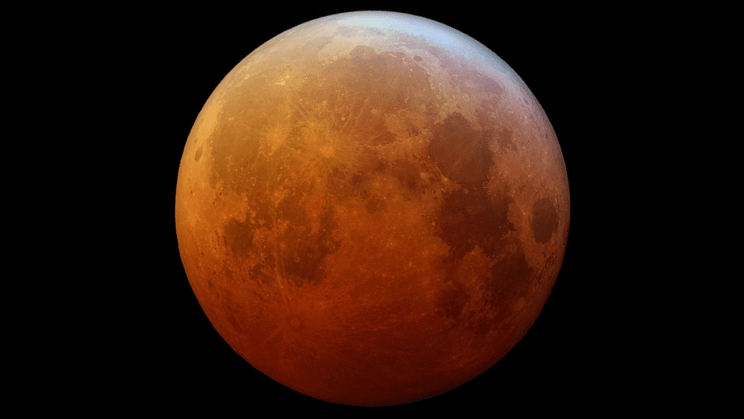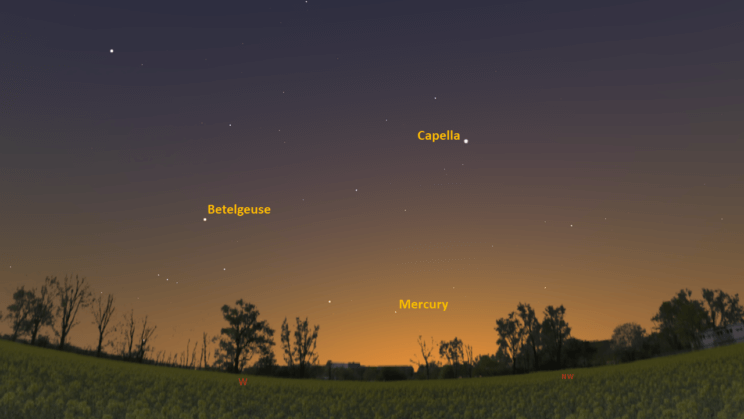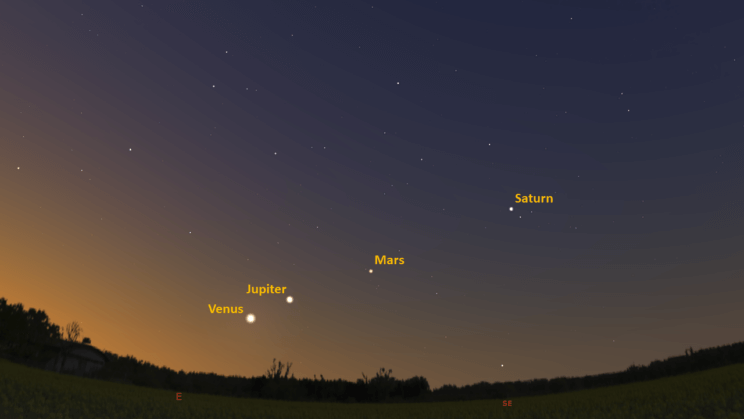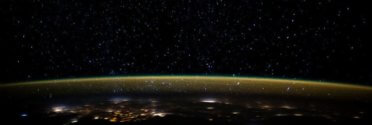This is the Saint Louis Science Center’s NIGHT SKY UPDATE for the week of Friday, May 6, 2022.
Information updated weekly or as needed.
Times given as local St. Louis time which is Central Daylight Time (CDT). For definitions of terminology used in the night sky update, click the highlighted text. If relying on times posted in Universal Time (UT), St. louis is -5 hours when CDT.
Public Telescope Viewings
With the changing recommendations from the CDC regarding COVID-19, conversations regarding the return of star parties at the Saint Louis Science Center have begun. We are close to bringing back our public telescope viewings, but a few details still need to be worked out. We will post future updates as we learn more about when we can bring back telescope viewings.
Observing Highlight of the Week

Total lunar eclipse seen from Oria, Italy on January 21. 2019. Image credit: Giuseppe Donatiello.
On May 15, 2022, the Moon will pass through Earth’s shadow causing a total lunar eclipse. The last total lunar eclipse seen in St. Louis was on January 20, 2019. Lunar eclipses are not rare, but they are not always visible where you live. In fact, every year there are at least two lunar and two solar eclipse that occur in pairs.
One of the oldest records of a lunar eclipse is found in a book discovered in 280 CE. The book was from Zhou Dynasty which documents a lunar eclipse that likely occurred on January 29, 1137, BCE. By carefully watching the behavior of the Sun and Moon, Ancient astronomers discovered the Moon and Sun appear to wander along the same path in the sky enabling them to predict eclipses. Clay tablets from the Late or Neo-Babylonian period are examples of the knowledge of eclipses in antiquity. Many of these clay tablets are astronomical journals that document the occurrence and the predictions of lunar and solar eclipses.
Cultures around the world observed eclipse, interpreting them in various ways. Most often, they were seen as something bad and as such, ancient people would behave in ways that they believed would bring a good end to the eclipse. The clashing of spears, electing a temporary ruler are but a few of these behaviors.
Today, we understand that eclipses are caused by an alignment of the Sun, Moon and Earth called a syzygy. A syzygy of the Sun, Moon and Earth happens every month when the Moon reaches new and full phase. In these phases, the Sun, Moon and Earth are in a more or less straight line. The reasons we do not experience an eclipse every month is because the Moon’s orbital plane is tilted regarding Earth’s orbital plane by 5.1°. Because of this, when the Moon reaches new or full moon, the alignment of the Sun, Moon and Earth is not a direct alignment. As the Moon orbits Earth, there are two points in its orbit called crossing or orbital nodes. These points are where the Earth’s and Moon’s orbital planes intersect. When new or full phases of the Moon occur at these crossing nodes, an eclipse will occur. The period between consecutive passes of the Moon through the same crossing node is 27.5 days which is called a draconic month.
When one eclipse occurs, the other type will occur about two weeks later. This pair of lunar and solar eclipses are called an eclipse season, which most years have two. The pairs are separated by roughly six months meaning every year there is a minimum of four eclipses: two lunar and two solar. The maximum number of eclipses that can occur, is seven in a year which last happened in 1982 and will next happen in 2038. In 2038, there will be 4 lunar eclipses and 3 solar eclipses. We will only see three of the four lunar eclipses.
A lunar eclipse can only occur when the Moon reaches its full phase. When a full moon occurs, the Moon is opposite the Sun with the Earth in between. If this occurs at a crossing node, the Moon will pass through Earth’s shadow. A shadow is the dark shape that falls on an object caused by an opaque body cutting off light from a source. Shadows have two regions called penumbra and umbra. The penumbra is the partially shaded outer region of a shadow and the umbra is the fully shade inner portion. These two regions of Earth’s shadow determine the type of eclipse we see.
During the eclipse on May 15, 2022, the Moon will fully pass into the Earth’s umbral shadow causing a total lunar eclipse. The eclipse begins when the Moon enters the penumbra at 8:32 p.m. Very little change will be seen until the Moon passes into the umbral shadow at 9:27 p.m. For about the next hour, the Moon will seem to disappear. Approaching the start of totality, the Moon will take on the red color associated with total lunar eclipses. Totality begins at 10:32 p.m. and will last until 11:53 p.m. The entire eclipse ends at 1:50 a.m. on May 16, 2022 when the Moon leaves Earth’s shadow. The entire eclipse lats 5 hours and 19 minutes and totality last 1 hour and 25 minutes.
No equipment is necessary to view a lunar eclipse but views of the surface can interesting. Of particular interest are the colors we see just before, during and just after totality. During totality, the Moon normally appears some shade of red but it can vary from a yellowish copper color to a deep red. The red color is the result of how the Sun’s light is refracted through Earth’s atmosphere. The Sun’s light is comprised of several frequencies or wavelengths of light. Everything from radio waves to gamma rays is emitted by the Sun. The colors seen in a rainbow are the wavelengths of light our brains are sensitive to. During a sunset, our atmosphere filters out the shorter visible wavelengths of light leaving the longer wavelengths such as orange and red. The same thing occurs during a total lunar eclipse. Even though the Earth is block light from the Sun, a little bit is refracted through Earth’s atmosphere making it to the lunar surface. If you were standing on the surface of the Moon during the eclipse, you would see a thin annulus of light surrounding the Earth which would likely have a reddish color. In 2008, the Japanese lunar orbiter Kaguya saw something similar. You can see the image released by JAXA here.
The variance in color discussed earlier is caused by the conditions of Earth’s atmosphere. Dust, smoke particles and other aerosols will impact the color we see. Volcanic eruptions, forest fires and dust storms are a few ways particles are lofted into our atmosphere. Depending on the particle size and uniformity, we see additional colors of light scattered as sunlight is refracted through our atmosphere. This causes a variance in color seen during a total lunar eclipse. The Danjon Scale is the system used to rate the appearance and luminosity of the Moon during totality.
We will have to wait until the 15th to see what this eclipse has in store for us. One of the things to keep an eye on is the weather. Long range forecasts are showing the likelihood of rain on the 15th. Predicted conditions can change and it is important to remember they are just predictions. Hopefully, the rain will move on by the evening but we will have to wait and see.
The Sun and Moon

The Moon as seen from the International Space Station, on July 31, 2011.
Credit: NASA
Sunrise is at 5:58 a.m. on Friday, May 6 and sunset is at 7:58 p.m. providing us with 14 hours of daylight. Even after sunset, the light from the Sun will dimly illuminate our sky for roughly 1 hour and 40 minutes. This period is called twilight, which ends around 9:41 p.m. this week. For those with a sundial, local noon occurs around 12:57 p.m. this week.
| Day | Sunrise | Sunset |
|---|---|---|
| 2022-05-06 | 5:58 a.m. | 7:58 p.m. |
| 2022-05-07 | 5:57 a.m. | 7:59 p.m. |
| 2022-05-08 | 5:56 a.m. | 7:59 p.m. |
| 2022-05-09 | 5:54 a.m. | 8:00 p.m. |
| 2022-05-10 | 5:53 a.m. | 8:01 p.m. |
| 2022-05-11 | 5:52 a.m. | 8:02 p.m. |
| 2022-05-12 | 5:52 a.m. | 8:03 p.m. |
| 2022-05-13 | 5:51 a.m. | 8:04 p.m. |
| 2022-05-14 | 5:50 a.m. | 8:05 p.m. |
Moon
Moonrise for Friday, May 6 occurred at 9:58 a.m. and moonset will occur at 1:31 a.m. on the following day. On Friday, May 6, the Moon will exhibit a waxing crescent phase with 31% of the lunar disk illuminated. First quarter phase occurs on May 8, 2022, at 7:21 p.m.
International Space Station (ISS) Observing

Visible passes of ISS from St. Louis for the week of May 6 occur during morning and evening hours. The best passes occur on the morning of May 12 and the evening of May 14. Use the table below for information about these and other visible passes this week.
Catch ISS from St. Louis starting Friday, May 6
| Date | Starts | Max. altitude | Ends | |||||||
|---|---|---|---|---|---|---|---|---|---|---|
| Time | Alt. | Az. | Time | Alt. | Az. | Time | Alt. | Az. | ||
| 08 May | -0.7 | 04:59:09 | 10 | NNW | 05:01:01 | 14 | NNE | 05:02:53 | 10 | NE |
| 10 May | -1.3 | 04:58:31 | 10 | NNW | 05:01:20 | 25 | NNE | 05:04:09 | 10 | E |
| 11 May | -0.8 | 04:10:23 | 10 | NNW | 04:12:45 | 18 | NNE | 04:15:06 | 10 | ENE |
| 12 May | -0.5 | 03:22:18 | 10 | NNW | 03:24:05 | 14 | NNE | 03:25:51 | 10 | NE |
| 12 May | -3.1 | 04:58:04 | 10 | NW | 05:01:23 | 59 | NE | 02:36:13 | 10 | NE |
| 12 May | -1.8 | 21:39:41 | 10 | SSW | 21:40:36 | 17 | SSW | 21:40:36 | 17 | SSW |
| 13 May | -2.1 | 04:09:46 | 10 | NW | 04:12:52 | 35 | NNE | 04:15:57 | 10 | E |
| 13 May | -2.6 | 20:51:50 | 10 | S | 20:54:29 | 22 | SE | 20:57:09 | 10 | ENE |
| 13 May | -2.2 | 22:27:57 | 10 | WSW | 22:31:04 | 37 | NNW | 22:34:10 | 10 | NE |
| 14 May | -1.3 | 03:21:31 | 10 | NNW | 03:24:16 | 23 | NNE | 03:27:01 | 10 | E |
| 14 May | -3.5 | 04:57:57 | 10 | WNW | 05:01:08 | 43 | SW | 05:04:17 | 10 | SSE |
| 14 May | -3.3 | 21:39:14 | 10 | WSW | 21:42:32 | 63 | NW | 21:45:51 | 10 | NE |
| 14 May | -0.5 | 23:17:58 | 10 | NW | 23:19:48 | 14 | NNW | 23:21:39 | 10 | NNE |
Magnitude (Mag): The Measure of brightness for a celestial object. The lower the value is, the brighter the object will be.
Altitude (Alt): The angle of a celestial object measured upwards from the observer’s horizon.
Azimuth (Az): The direction of a celestial object, measured clockwise from an observer’s location with north being 0°, east being 90°, south being 180° and west being 270°.
For information about ISS flyovers and other visible satellites, visit www.heavens-above.com
Detailed information regarding all unmanned exploration of our universe, missions past, present, and planned, can be found at Jet Propulsion Laboratories:
The Visible Planets

Looking west at 8:20 p.m. on May 6, 2022. Credit: Stellarium, EG

Looking southeast at 5:20 a.m. May 7, 2022. Credit: Stellarium, EG
This week, all five naked eye planets are visible. Venus, Mars, Jupiter and Saturn are seen in the east and southeast before sunrise. Mercury will be found low in the west after sunset.
Mercury
Mercury is still visible about 30 minutes after sunset in the west, but our viewing window is beginning to shrink. Mercury is head towards inferior conjunction on May 21, 2022.
Venus
Venus has started a morning apparition and will be seen in the southeast before sunrise. Venus rises at 4:20 a.m. and should be easy to spot in the southeast by 5:10 a.m. The current morning apparition lasts until the third week of October 2022. Venus reaches superior conjunction on October 22, 2022.
Mars
A new apparition for Mars has begun. Mars rises at 3:35 a.m. Start looking for Mars around 4:30a.m. as it clears trees and buildings. Mars will continue to climb out of the Sun’s glare as it heads towards opposition later this year on December 7, 2022.
Jupiter
Jupiter rises at 4:03 a.m. and should be visible by 5:00 a.m. As the year goes on, Jupiter will rise about 20 minutes earlier than it did the week before. Jupiter will reach opposition on September 26, 2022, so our best views of this giant world will come at the end of summer and through the fall months.
Saturn
Saturn rises at 2:36 a.m. Start looking for Saturn around 3:30 a.m. in the southeastern sky. Saturn will reach opposition on August 14, 2022. As we head to this date, Saturn will rise earlier each day.
James S. McDonnell Planetarium
Night Sky Update: May 6 – May 14, 2022







